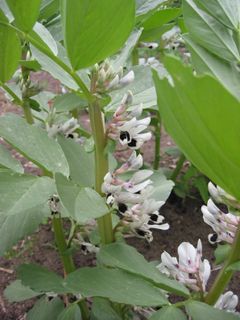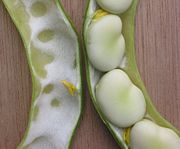Vicia faba
2008/9 Schools Wikipedia Selection. Related subjects: Plants
| Vicia faba | ||||||||||||||||||
|---|---|---|---|---|---|---|---|---|---|---|---|---|---|---|---|---|---|---|
 Vicia faba plants in flower
|
||||||||||||||||||
| Scientific classification | ||||||||||||||||||
|
||||||||||||||||||
| Binomial name | ||||||||||||||||||
| Vicia faba L. |
Vicia faba, the broad bean, fava bean, faba bean, horse bean, field bean, tic bean is a species of bean ( Fabaceae) native to north Africa and southwest Asia, and extensively cultivated elsewhere. Although usually classified in the same genus Vicia as the vetches, some botanists treat it in a separate monotypic genus as Faba sativa Moench.
It is a rigid, erect plant 0.5-1.7 m tall, with stout stems with a square cross-section. The leaves are 10-25 cm long, pinnate with 2-7 leaflets, and of a distinct glaucous grey-green colour; unlike most other vetches, the leaves do not have tendrils for climbing over other vegetation. The flowers are 1-2.5 cm long, with five petals, the standard petal white, the wing petals white with a black spot (true black, not deep purple or blue as is the case in many "black" colourings ), and the keel petals white. The fruit is a broad leathery pod, green maturing blackish-brown, with a densely downy surface; in the wild species, the pods are 5-10 cm long and 1 cm diameter, but many modern cultivars developed for food use have pods 15-25 cm long and 2-3 cm thick. Each pod contains 3-8 seeds; round to oval and 5-10 mm diameter in the wild plant, usually flattened and up to 20-25 mm long, 15 mm broad and 5-10 mm thick in food cultivars. Vicia faba has a diploid (2n) chromosome number of 12, meaning that each cell in the plant has 12 chromosomes (6 homologous pairs). Five pairs are acrocentric chromosomes and 1 pair is metacentric.
Cultivation and uses
Broad beans have a long tradition of cultivation in Old World agriculture, being among the most ancient plants in cultivation and also among the easiest to grow. It is believed that along with lentils, peas, and chickpeas, they became part of the eastern Mediterranean diet in around 6000 BC or earlier. They are still often grown as a cover crop to prevent erosion because they can over-winter and because as a legume, they fix nitrogen in the soil. These commonly cultivated plants can be attacked by fungal diseases, such as Rust ( Uromyces viciae-fabae) and Chocolate Spot ( Botrytis fabae).
In much of the Anglophone world, the name broad bean is used for the large-seeded cultivars grown for human food, while horse bean and field bean refer to cultivars with smaller, harder seeds (more like the wild species) used for animal feed, though their stronger flavour is preferred in some human food recipes, such as falafel. The term fava bean (from the Italian fava, meaning "broad bean") is its most common name in the United States, with broad bean being the most common name in the UK.
Culinary uses
Broad beans are eaten while still young and tender, enabling harvesting to begin as early as the middle of spring for plants started under glass or over-wintered in a protected location, but even the maincrop sown in early spring will be ready from mid to late summer. Horse beans, left to mature fully, are usually harvested in the late autumn.
The beans can be fried, causing the skin to split open, and then salted and/or spiced to produce a savory crunchy snack. These are popular in China, Peru (habas saladas), Mexico (habas con chile) and in Thailand (where their name means "open-mouth nut").
In the Sichuan cuisine of China, broad beans are combined with soybeans and chili peppers to produce a spicy fermented bean paste called doubanjiang.
In most Arab countries the fava bean is used for a breakfast meal called ful medames. Ful medames is usually crushed fava beans in a sauce although the Fava beans do not have to be crushed.
Egypt
Fava beans are the most common fast food in the Egyptian diet. It is eaten by rich and poor. Egyptians eat fava beans in various ways. Fava beans are shelled then dried. They are bought dried and then cooked by adding water in very low heat for several hours. The most popular way of preparing fava beans in Egypt is by taking the cooked fava beans and adding oil, lemon, salt and cumin to it. It is then eaten with bread. Traditionally, Egyptians eat onions with it.This famous dish is called ful medames.
Health issues
Broad beans are rich in tyramine, and thus should be avoided by those taking monoamine oxidase (MAOI) inhibitors.
Raw broad beans contain vicine, isouramil and convicine, which can induce hemolytic anaemia in patients with the hereditary condition glucose-6-phosphate dehydrogenase deficiency (G6PD). This potentially fatal condition is called "favism" after the fava bean.
Broad beans are rich in L-dopa, a substance used medically in the treatment of Parkinson's disease. L-dopa is also a natriuretic agent, which might help in controlling hypertension. Some also use fava beans as a natural alternative to drugs like Viagra, citing a link between L-dopa production and the human libido. The Broad beans is widely cultivated in district Kech and Panjgur of Balochistan Province of Pakistan and eastern province of Iran. In Balochi language it is called Bakalaink and Baqala in Persian The elders generally restrict the young children from eating it raw(when unmatured)because it can cause constipation and jaundice like symptoms.
Areas of origin of the bean correspond to malarial areas. There are suggestions that the anaemia resulting from favism acts as protection from malaria, because certain species of malarial protozoa cannot prosper in blood lacking in iron.
Other uses
- In ancient Greece and Rome, beans were used in voting; a white bean being used to cast a yes vote, and a black bean for no.
- In Ubykh culture, throwing beans on the ground and interpreting the pattern in which they fall was a common method of divination ( favomancy), and the word for "bean-thrower" in that language has become a generic term for seers and soothsayers in general.
- In Italy, broad beans are traditionally sown on November 2, All Souls Day. Small cakes made in the shape of broad beans (though not of them) are known as fave dei morti or "beans of the dead". According to tradition, Sicily once experienced a failure of all crops other than the beans; the beans kept the population from starvation, and thanks were given to Saint Joseph. Broad beans subsequently became traditional on Saint Joseph's Day altars in many Italian communities. Some people carry a broad bean for good luck; some believe that if one carries a broad bean, one will never be without the essentials of life. In Rome, on the first of May Roman families traditionally eat fresh fava beans with Pecorino Romano cheese during a daily excursion in the Campagna.
- In Portugal a Christmas Cake called Bolo Rei is baked with a "Fava" bean inside.
- In ancient Greece and Rome, beans were used as a food for the dead, such as during the annual Lemuria festival. In some folk legends, such as in Estonia and the common Jack and the Beanstalk story, magical beans grow tall enough to bring the hero to the clouds. The Grimm Brothers collected a story in which a bean splits its sides laughing at the failure of others. Dreaming of a bean is sometimes said to be a sign of impending conflict, though others said that they caused bad dreams. Pliny claimed that they acted as a laxative. European folklore also claims that planting beans on Good Friday or during the night brings good luck.



